Homemade Ground Beef Jerky Recipe (For Dehydrator or Oven)
This post may contain affiliate links. Read my full disclosure here.
Ground beef jerky is easy to make and less expensive than store-bought jerky. You can make it with a dehydrator or dry it in the oven. Use your choice of ground meat – lean beef or venison – whichever you have available.
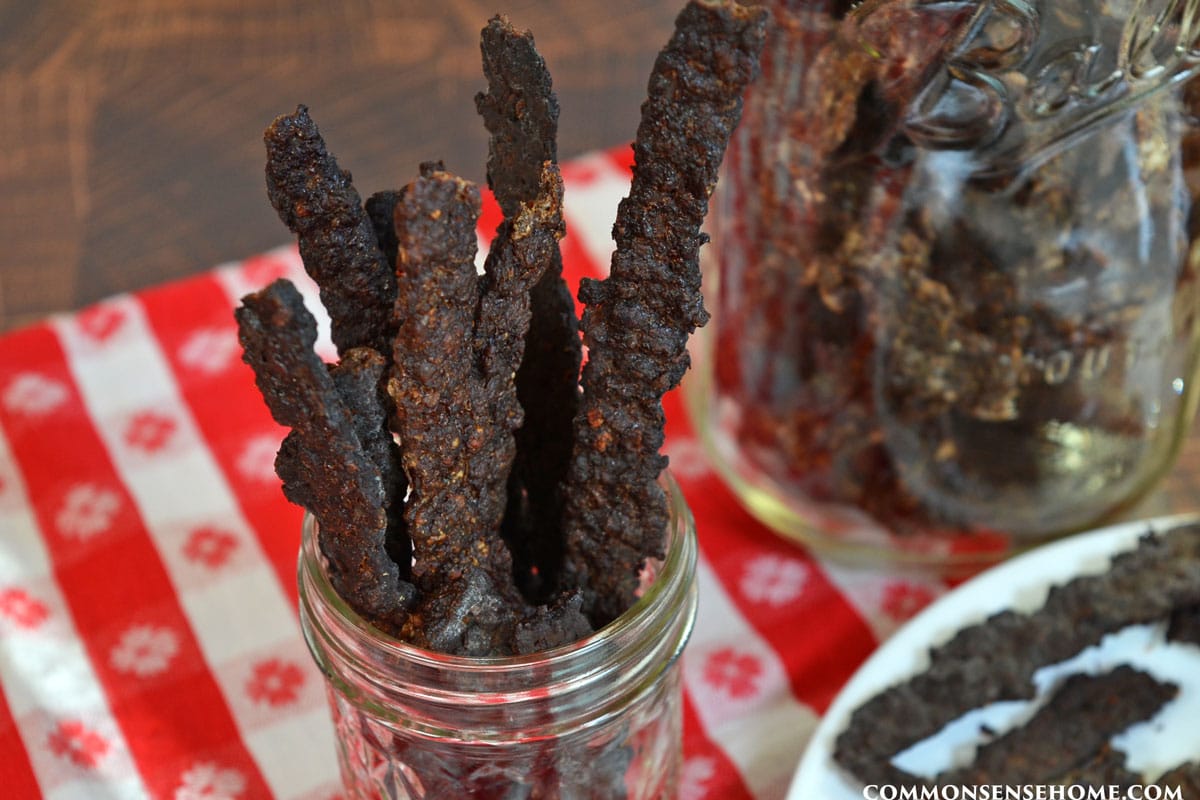
My jerky gun came with seasoning and cure packets. Unfortunately, these were full of ingredients I’m trying to avoid in commercial jerkies (MSG, hydrolyzed soy protein, nitrates, etc.). (Those little packets are expensive, too, if you purchase them separately.)
This recipe uses soy sauce and sea salt for preserving instead of curing salt. It doesn’t contain nitrites or nitrates.
Do you need a jerky gun to make jerky with ground beef? Nope! You can make jerky without a dehydrator or a jerky gun, but the jerky gun is handy and entertaining.
We have a basic Nesco jerky gun. For those who want to make big batches of jerky, try the LEM jerky cannon.
Why Use Ground Beef for Homemade Jerky Instead of Beef Strips?
I prefer ground beef jerky for three main reasons:
- It’s cheaper. I can get ground beef or venison much cheaper than a roast.
- It’s easier to make. Working the jerky gun or rolling the meat out thinly goes quickly. Wrestling to cut strips out of a piece of meat with bone and connective tissue intact is tough.
- It’s easier to chew. Eating a piece of regular muscle jerky can sometimes be like chewing on an old shoe, especially when there’s a lot of connective tissue. Ground beef jerky has the meaty, salty jerky taste we love, without getting stuck in your teeth.
This recipe is adapted from Mary Bell’s Complete Dehydrator Cookbook – “All American Marinated Beef Jerky”. Mary makes hers with beef strips, but it worked well as a ground beef jerky recipe, too.
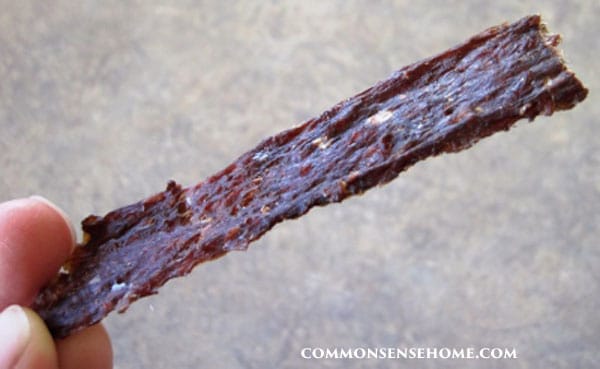
How to Reduce Sodium in Beef Jerky
For the soy sauce, I prefer grain free organic tamari. Most US non-organic soy is genetically modified, and may have glyphosate residue. Non-organic wheat may be sprayed with glyphosate prior to harvest.
I use San-J, which has 940 mg of sodium per tablespoon. In comparison, La Choy has 1330 mg. A tablespoon of regular table salt has 6976 mg of sodium(2325 mg per teaspoon).
If you use a saltier soy sauce, it’s easy to overdo the salt in the recipe. Stick with a soy sauce that has less sodium. If you want to skip the teaspoon of sea salt, store the finished jerky in the fridge or freezer. Salt is a preservative.
If your finished jerky is still too salty, you can soak it for 15-20 minutes to remove surface salt, then dry it again. Store the de-salted jerky in the refrigerator or freezer. Another option is to use the salty jerky for flavoring another dish, so the saltiness is diluted.
Homemade Ground Beef Jerky Recipe
Ingredients
- 1/2 cup soy sauce
- 1 teaspoon liquid smoke
- 1/2 teaspoon onion powder
- 1/2 teaspoon garlic powder or 1 teaspoon minced garlic
- 1 teaspoon sea salt
- 1 pound lean ground beef or venison, at least 93% lean
Directions
In a glass bowl, combine all ingredients and let sit (refrigerated) for at least two hours. I mixed this up at bedtime and let it sit until after lunch the next day, and it wasn’t too strong.
Load the mixture in the jerky gun and use the gun to load your dehydrator trays. I do recommend using the mesh inserts or fruit leather trays for your dehydrator. This mixture is fairly soft because of the liquid ingredients, which makes it easier to fire through the gun.
If you don’t have a jerky gun, use a rolling pin to roll the mixture out very thinly (1/8 inch thick). Score lines to form long strips of jerky.
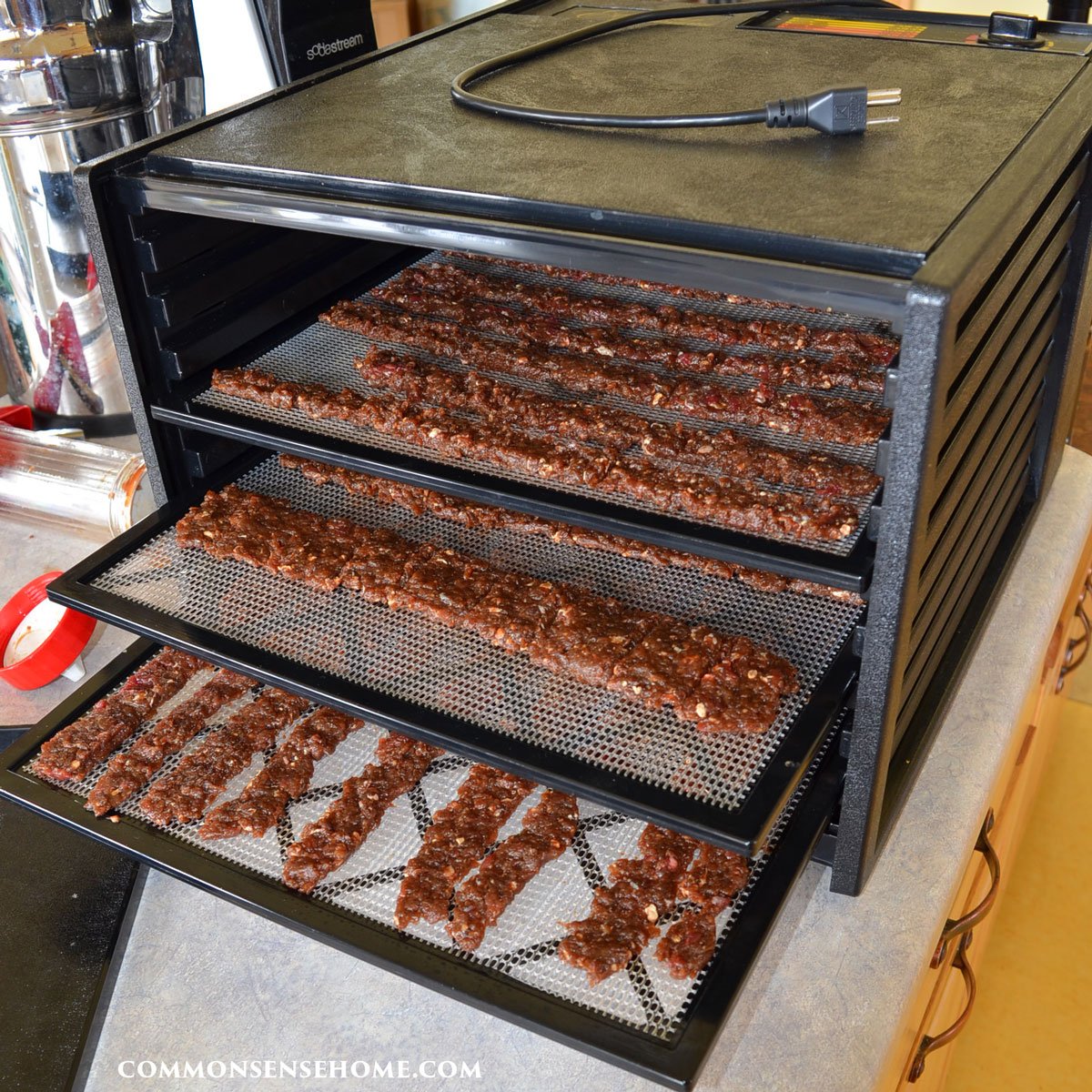
Dry at 145° – 165°F (63° – 74° C) for 4 to 12 hours. The jerky should be hard but still flexible and contain no pockets of moisture. For extra safety, heat finished jerky in a 275° F (135° C) oven for 10 minutes.
Jerky will last in an airtight container at room temperature for 1 – 2 months. For longer storage, place in an airtight container in the refrigerator or freezer. Vacuum sealing extends shelf life.
How Much Homemade Jerky Do You Get from One Pound of Raw Meat?
The weight of the jerky decreases by about two-thirds during the drying time. So for every pound of raw meat you use, you’ll get around one-third pound of finished homemade jerky.
How Can I Be Sure My Jerky is Safe to Eat?
The University of Wisconsin suggests the following two options for safe jerky making at home:
- Dry meat at 145° – 155°F for at least 4 hours followed by heating in a preheated 275°F oven for 10 minutes. Drying meat at a temperature below 145°F produces a product that looks done before it is heated enough to destroy pathogens, and before it has lost enough moisture to be shelf-stable.
Only a few dehydrators currently on the market will maintain the necessary temperature of 145° – 155°F. The Gardenmaster by Nesco/American Harvest and the Excalibur are two such units.
Each of these units has a large heating element, strong air flow, and adjustable temperature setting. Dry for at least 4 hours (6 hours is preferable) and remove jerky from the dehydrator.
Place dried strips on a baking sheet, close together but not touching or overlapping. Heat in a pre-heated 275°F oven for 10 minutes to an internal temperature of 160°F. Strips thicker than ¼” (when raw) may require longer to reach 160°F.
In our research, strips removed from the oven were sizzling hot. Remove oven-heated samples from the oven, cool to room temperature, and package. Always include the post‐drying oven‐heating treatment as a safety precaution.
- Steam or roast meat strips in marinade to an internal temperature of 160°F before drying. Heat poultry to 165°F (internal temperature) before drying. The USDA Meat and Poultry Hotline currently recommends this method for making safe jerky.
The pre‐heating step assures that any bacteria present will be destroyed before drying. This allows a lower dehydrator temperature (130° to 140°F) to be used. After boiling, dehydrate meat for 4 to 6 hours. No post-dehydration oven-heating is necessary.
Since it can be impossible to accurately measure the internal temperature of a thin strip of meat, consumers can boil meat in marinade (or water) for 5 minutes before drying. Unfortunately, this USDA recommended method produces a dried, crumbly product. It would be judged inferior by Wisconsin standards for chewy, flexible jerky.
Holding meat above 145°F for over an hour pasteurizes the meat. Pathogens start dying at temperatures above 130°F, but the lower the temp, the longer they take to kill.
Would you like to save this?
We get our beef or venison from a single animal, so I use the dehydrator above 145°F and call it good. If you had ground beef from unknown animals, I’d suggest some time in the oven to finish it.
Do I Need a Dehydrator to Make Jerky?
It’s possible to make jerky without a dehydrator. Here’s how to make jerky in the oven.
Roll out the jerky on a piece of parchment paper and place it on a baking sheet (or use a jerky gun). Dry the homemade jerky at your oven’s lowest temperature with the door slightly open for 2 hours. Our oven’s minimum temperature is 170°F (77°C).

Flip the jerky and rotate the baking sheet. Bake for 1-2 hours more, until jerky is dry but flexible. Oven drying jerky shrinks it up faster and plumper, and creates more of a salty crust.
Using the Excalibur Dehydrator and Jerky Gun
With the Excalibur dehydrator, a batch of jerky is done in about 4-6 hours, depending on the humidity level. Drying overnight gets the jerky a little too dry for my taste. It’s still good, but a little too crumbly.
The last time we made jerky, my eldest mixed up the jerky marinade and meat the evening before drying. My youngest loaded up the Excalibur the next morning.
Make sure to pack the ground meat tightly into the tube to avoid air pockets. The jerky gun shoots strips about an inch wide when you use the “double barrel” attachment. The gun also has option of a single wide strip or a tube shape.
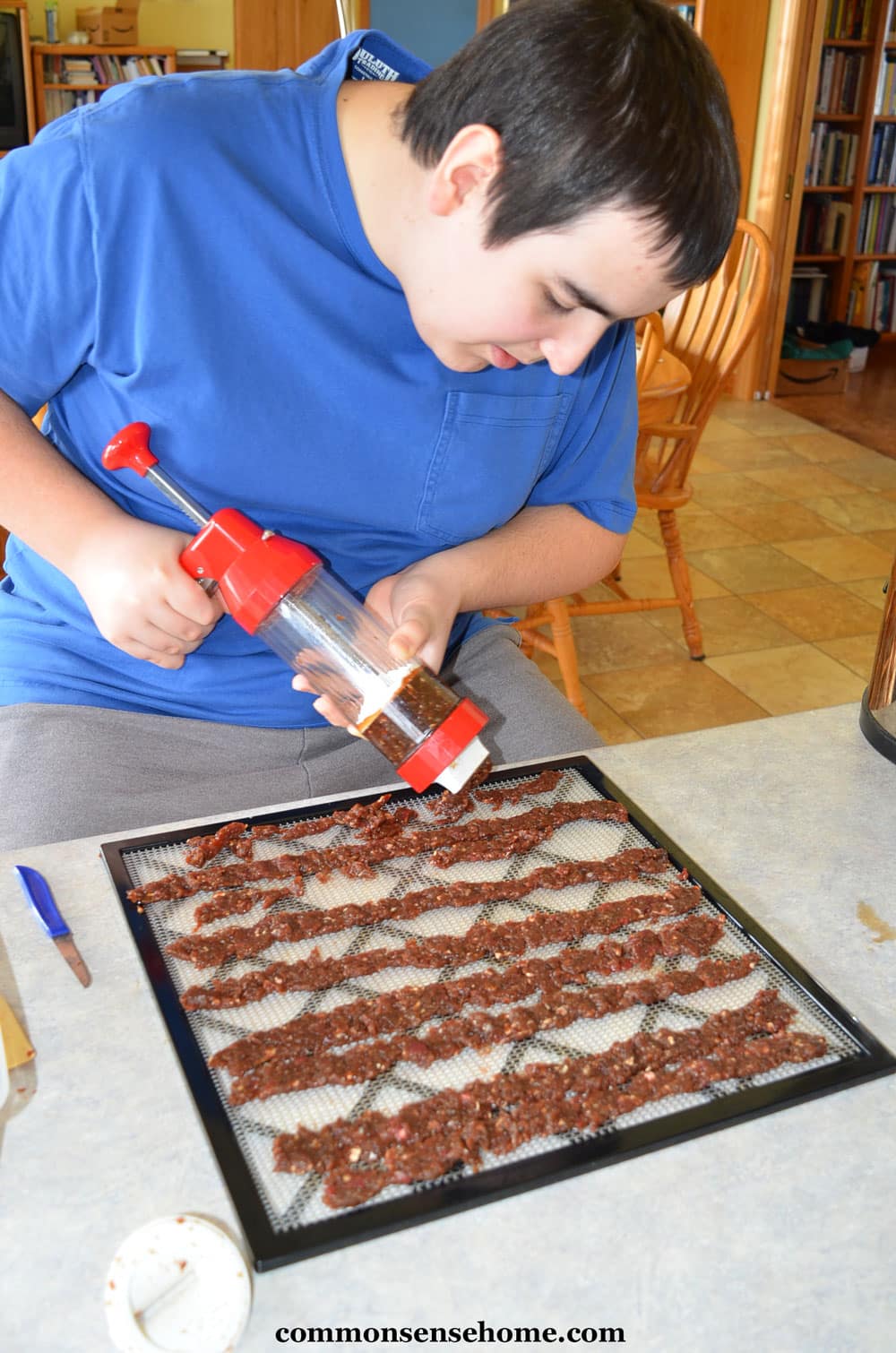
We made wide strips and scored them with a thin spatula. This makes them easier to break apart once dry. (You can use this same scoring technique for jerky made with a rolling pin.)
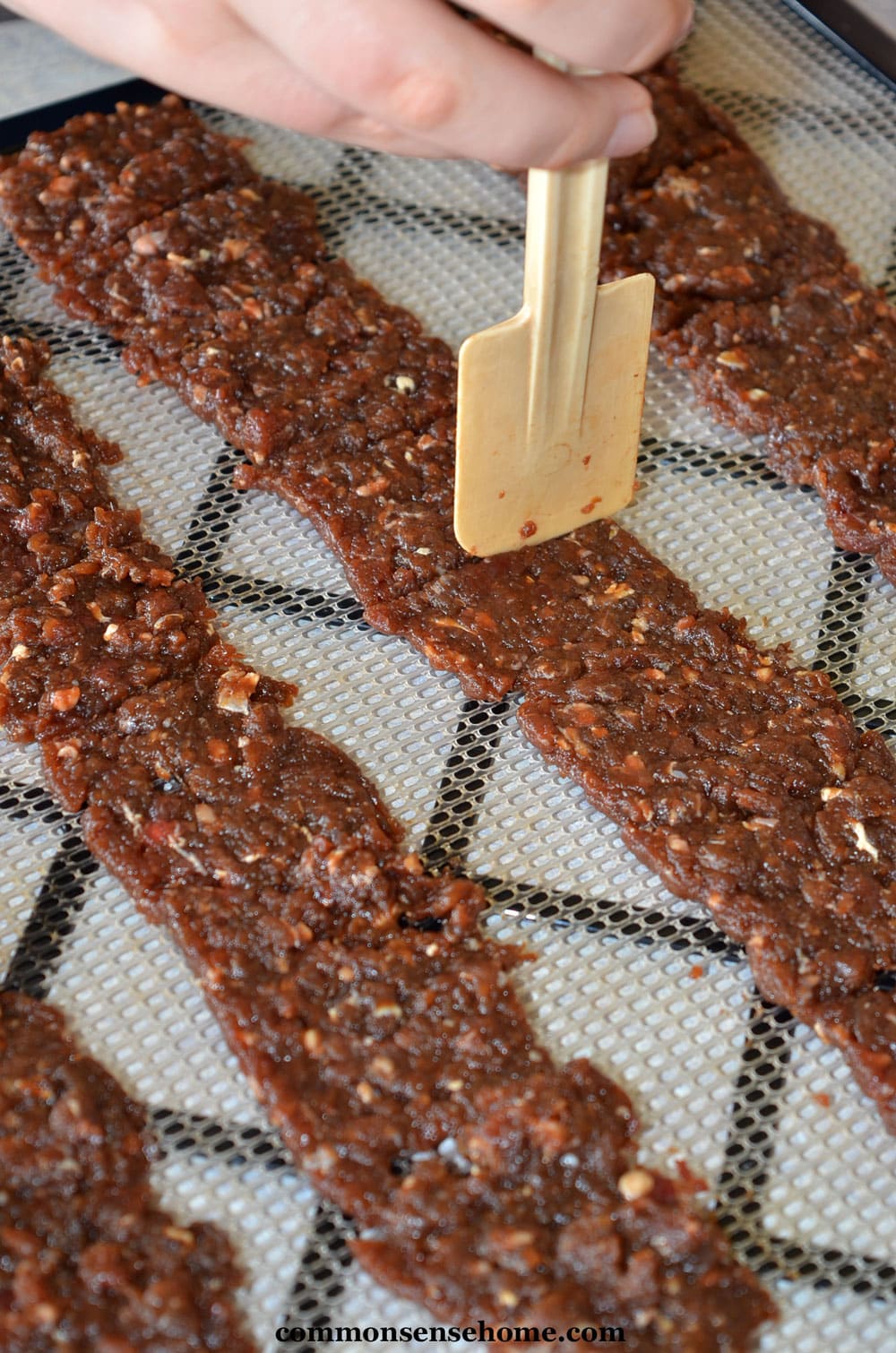
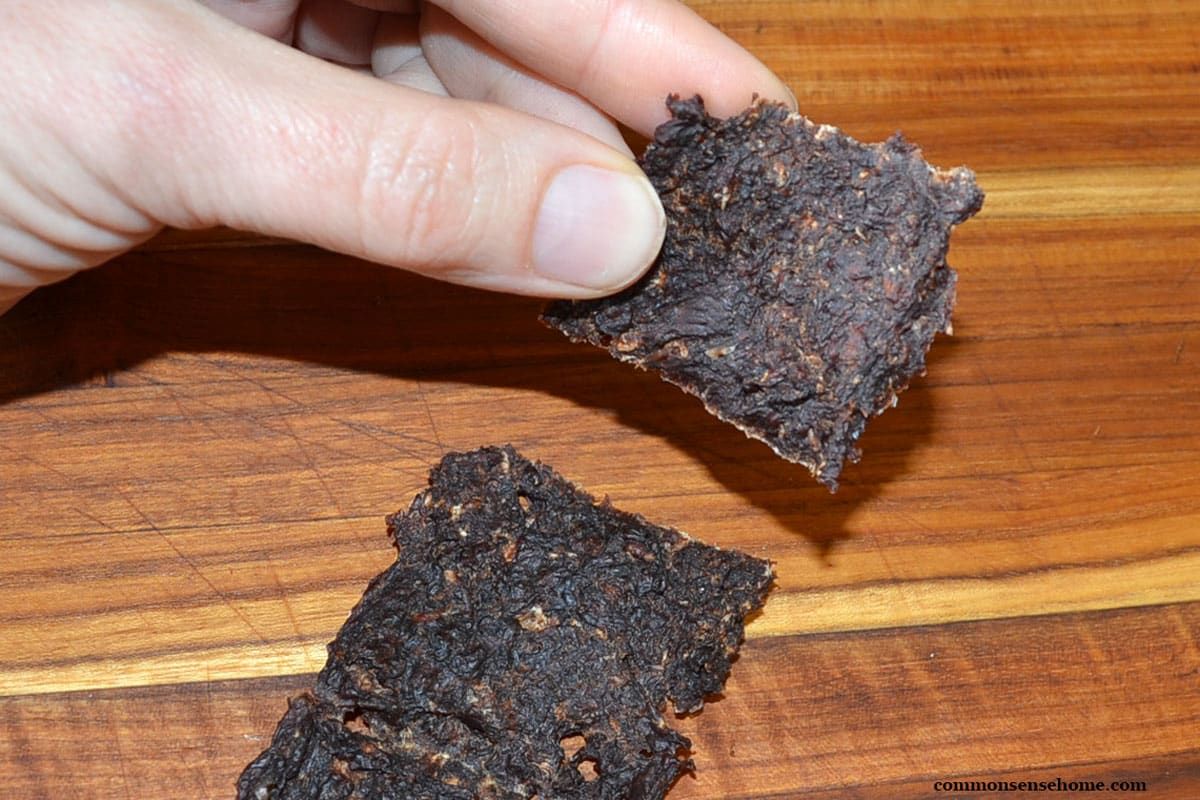
This has become one of my favorite snack foods since we’ve been working to reduce our carbohydrate and grain intake. It’s relatively quick and easy to make, and the gun was pretty inexpensive.
Homemade Jerky without Soy Sauce (Gluten Free, Soy Free Option)
For those who avoid soy and/or gluten, substitute liquid coconut aminos for the soy sauce. Coconut aminos have a similar flavor profile, and are gluten free and soy free.
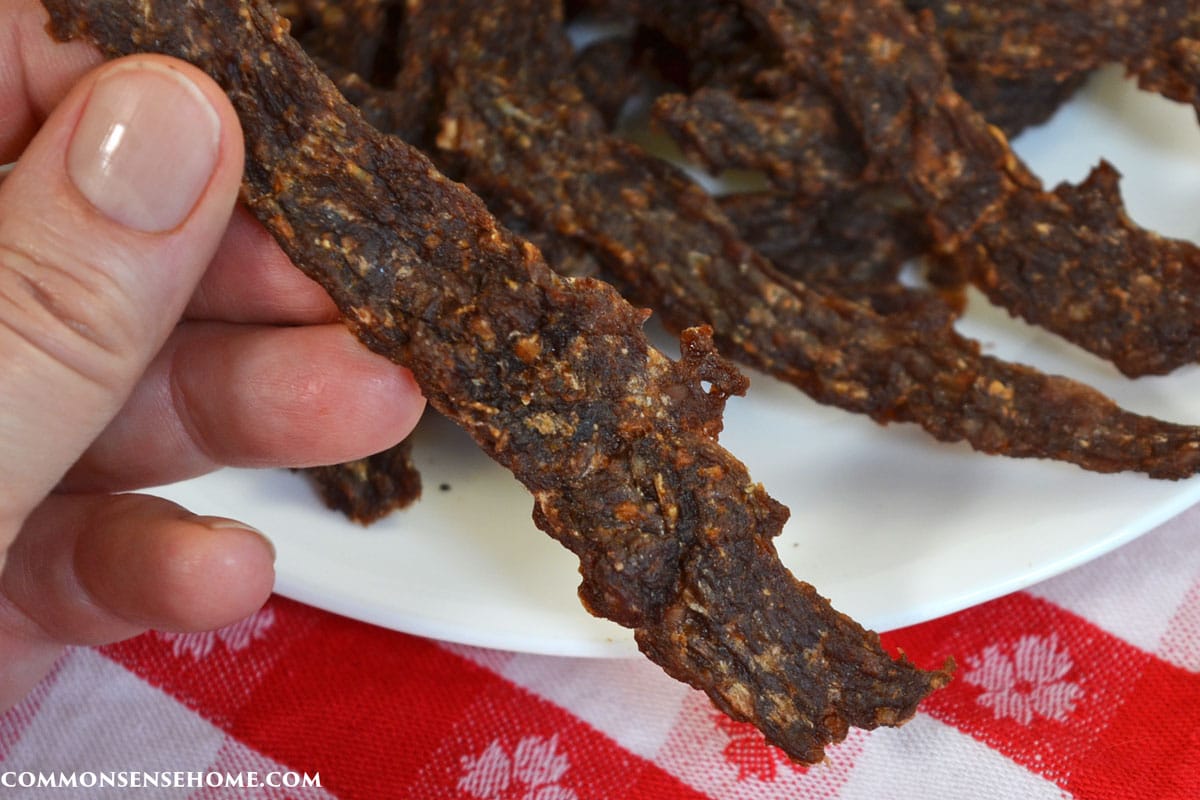
Beef Jerky Recipe with Ground Beef
Easy and economical jerky recipe that’s great for lean beef or venison.
- Prep Time: 10 minutes
- Drying Time: 4 hours
- Total Time: 4 hours 10 minutes
Ingredients
- 1/2 cup soy sauce
- 1 teaspoon liquid smoke
- 1/2 teaspoon onion powder
- 1/2 teaspoon garlic powder or 1 teaspoon minced garlic
- 1 teaspoon sea salt
- 1 pound lean ground beef or venison, at least 93% lean
Instructions
- In a glass bowl, combine all ingredients and let sit (refrigerated) for at least two hours. I mixed this up at bedtime and let it sit until after lunch the next day, and it wasn’t too strong.
- Load the mixture in the jerky gun and use the gun to load your dehydrator trays. I do recommend using the mesh inserts or fruit leather trays for your dehydrator. This mixture is fairly soft because of the added liquid, which makes it easier to fire through the gun.
- If you don’t have a jerky gun, roll the mixture out very thinly (1/8 inch thick) and score lines where you would like the pieces to break apart.
- Dry at 145° – 165° F (63° – 74° C) for 4 to 12 hours, until jerky is hard but still flexible and contains no pockets of moisture. For extra safety, heat finished jerky in a 275° F (135° C) oven for 10 minutes.
For oven drying:
Roll out the jerky on a piece of parchment paper and place it on a baking sheet (or use a jerky gun). Dry the homemade jerky at your oven’s lowest temperature with the door slightly open for 2 hours. Our oven’s minimum temperature is 170°F (77°C).
Flip the jerky and rotate the baking sheet. Bake for 1-2 hours more, until jerky is dry but flexible. Oven drying jerky shrinks it up faster and plumper, and creates more of a salty crust.
Notes
Jerky will last in an airtight container at room temperature for 1 – 2 months. For longer storage, place in an airtight container in the refrigerator or freezer. Vacuum sealing extends shelf life.
Do you have a favorite jerky recipe? Have you tried making jerky with ground beef? Has anyone tried making jerky out of organ meats? I’d love to hear from you.
Recommended Dehydrators
- Nesco Gardenmaster Dehydrator
- 9 Tray Excalibur Dehydrator – This is the unit we have.

More Snack Recipes
More Food Storage
Home Food Drying – 6 Things you Need to Know
Food to Stock Up On (For Daily Use or Emergencies)
Dehydrator vs Freeze Dryer – What’s the Difference?

This article is written by Laurie Neverman. Laurie grew up in the kitchen, learning baking and home cooking from her momma. At age 15, she and her mom and two sisters created Irene’s Custom Cakes & Catering, which was her summer job through most of high school and college.
Last updated in 2024.

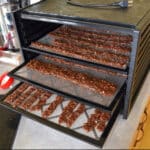
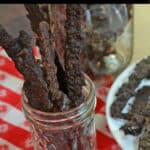


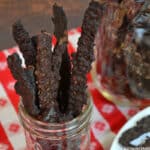
If you wanted to run a full dehydrator, would you need to rotate the trays (using an Excalibur)?
Because of the high powered fan being located perpendicular to the drying surfaces, Excaliburs tend to dry fairly evenly, but it certainly wouldn’t hurt anything to rotate midway through drying. That would give you a chance to check everything, flip strips if you like, and possibly remove of rotate out to the edges any strips that are much thinner than the average strip.
Is the Soy sauce only for flavor? Or necessary for preservation? I prefer to stay away from soy at all.
It’s primarily for flavor, but does aid in preservation due to the salt content. If you need/want to avoid soy, I’d suggest substituting coconut liquid aminos, such as Better Body Foods Organic Coconut Aminos. Coconut aminos are commonly used as a soy sauce replacement and have a similar flavor profile.
I have a Cabela’s dehydrator. I love it, right down to the quality of the build compared to every other dehydrator I’ve owned. And I’ve owned about every dehydrator you could buy, including the Excalibur.
I live in farm country (apples, cherries and row crops) and, until I got my freeze dryer, it got a LOT of use. For example, I’d dehydrate apples by the apple box (40 pounds).
NOW, the down side. When it comes to jerky, the high end Cabela units fall short. They do not get hot enough to make jerky. As such, it’s off to the convection oven or air fryer that have settings just for this use.
Thanks for letting me know. I haven’t worked with their dehydrators.
I found a comment on a page discussing the Cabela dehydrator (https://www.youtube.com/watch?v=9By_L1i9BnU). It and other comments on that YouTube page cast a whole different light on the matter:
“You need to talk to a food scientist…seriously…and yes, that’s an actual title. Foodborne pathogens DO NOT require 160F to effectively pasteurize them, including Escherichia coli O157:H7…the bad one. To be perfectly clear, an efffective pasteurization of E. coli as defined by the USDA means a 7 D reduction in pathogens, or killing of 99.99999% of the organisms. There are multiple ways to make this happen. You can do it in under a second at 160F(it is actually 158F but that’s hard to read on a 1” diameter dial thermometer), …OR… you can MAINTAIN an internal temperature of 145F for 3 minutes and get the EXACT SAME REDUCTION OF ORGANISMS. This is for uncured, 70% lean ground beef without pH modifiers. If you reduce the fat % or add acid, the times are even SHORTER, but not by much! This is scientific data and these are facts published by the USDA. It is called the thermal death-curve or thermal inactivation rate and it is slightly different for each pathogen. For the most part, E coli and Salmonella are the worst offenders, and when we’ve killed enough of those, we’ve killed enough of everything else. I could give you hundreds of reference documents that would take hours to read, or you could do a quick google search for “Temperature and Time Requirements for Food UMN” and click on the first item that comes up from University of Minnesota Extension. You will see 155F for 15 sec, or 150 for 1 min or 145 for 3 minutes for ground meats.
Why do we see USDA recommendations of 160F? That 160F temperature is for the masses…the general population…with an IQ range of 50 to 150. You try explaining a time vs temperature pasteurization curve for a 7 D reduction of E. coli or 6.5 D reduction of Salmonella to the 16 year-old burger-flipper at Mickey D’s or the Waffle Hut over on State Rt 47 and see how successful you are!!
I understand what I have told you goes against everything you’ve ever been taught regarding food safety, but I assure you it is true and accurate and food processing facilities around the world count on the effectiveness of those time vs temp values.
So…you were at 145F or higher for HOW LONG? Hours?!?!! Dude, your beef-jerky is INCREDIBLY safe to eat!!!!”
Actually, we discuss pasteurization elsewhere in the comments, but as you note, both the “official” dogma and some concerned persons want extra protection.
Bacteria also needs free water to multiply. Salt binds up water.
This is a recipe I have wanted to try for a long time and just completed a large batch. We dehydrated the jerky in an Excalibur unit at 150 degrees for 6 hours and then baked it for 10 – 15 minutes in the oven at the 275. While it tastes GREAT, my jerky seems to be a bit greasy even though we used lean ground beef. Like had to wipe off the grease, greasy.
Is that normal or did I not hydrate it long enough? Also, I have stored the jerky in Mylar bags with a food grade oxygen absorbing packet. In your opinion, is that safe enough to store on the shelf for a few months or should we take extra precautions based on the above?
Thank you for your website and sharing your knowledge. Having lots of fun being a better steward of our home and lands!
Extra time in the dehydrator or oven won’t make meat less greasy, so you didn’t do anything wrong there.
The jerky is plenty salty, so with the Mylar and the O2 absorber, it should be shelf stable for a short time. Oxygen is what causes rancidity when it interacts with the fat, so the airtight packaging in combination with the O2 absorber should take care of that. If you have extra freezer or fridge space, that’s great, but it should be okay. I’ve noticed with longer storage in Mylar that meat with any fat tends to pick up a hint of metallic flavor. Edible, but not as tasty.
When you say “lean”, how lean? I’ve gotten used to using grassfed beef or ground venison. Both of these can be cooked for other recipes and I don’t need to pour off excess fat. If the beef you’re using would require that you pour off excess fat if you browned it, then it would make sense that the jerky would also have some excess fat.
Thank you for your kind words. We’re feeling the stress of all the crazy going on, so it’s much appreciated.
Could you make “jerky” using jarred meat purees? I’ve got lots of extra baby food. Thanks
I think the fine texture of the puree would make jerky with the meat only somewhat unpleasant, but a friend of mine suggested mixing the meat puree with flour until you get a doughy consistency. Roll the dough think and slice with a pizza cutter after dry-frying, then dehydrate to crispy. I don’t think standard jerky proportions for seasonings would work well, so you’d need to experiment.
Thank you
Glyphosate is not a danger to anyone! The very minuscule amount that maybe might possibly be in any food will not harm you! I’ve used it extensively for many many years and have no ill effects from it!
I disagree with you. It was patented as an antibiotic, as as such is destructive to the soil biome, at the very least.
Many of us prefer to error on the side of caution. Especially since no one seems willing to establish a million dollar bond, even if we pay for it, guaranteeing the herbicide is safe. And there is that Roundup has already paid out millions for injuries common to individuals who used the stuff.
I just finished 5 lbs of hamburger without the added salt….I thought the salt content of the soy sauce would be adequate…..now I’m worried that my jerky won’t be preserved
Best to keep it in the fridge or freezer for longer storage.
Can Ground turkey be used? Can I replace the sea salt with pink curing salt?
If you want to use turkey, it’s probably best to precook the meat to 165F before drying to eliminate bacteria per USDA guidelines. Yes, you could use pink curing salt, which contains nitrates and nitrites to increase shelf life.
I put the dehydrated jerky ( Not precooked) into a 275 oven for 20 minutes. Texture was perfect.
Thanks for sharing what worked for you.
Has anyone tried using the coconut aminos instead of the soy sauce?
No, but if the sodium content is similar, it should be fine.
Oh Darn! I am so confused! Should I make and dehydrate first then finish cooking in oven to remove “the bad stuff” or should I cook the whole pkg of meat at one time FIRST so temp is 160 then dehydrate? Do I cook it like a meat loaf with all the other ingredients mixed in, then cool and put into the jerky gun?? I’ve made jerky before but always used the pkg mixes…I can’t have MSG, so this looks so good to me, but…I want to be as safe as possible.
If you cook it first, it will not work in a jerky gun. If you’re concerned about possible bacterial contamination, make the jerky, then heat it (pasteurize it) in the oven. Some dehydrators now have higher heat settings, too, so you may be able to bring it up to temp right in your dehydrator.
Hi! I KNOW there are tons of questions and comments. I hope you won’t laugh…
I, too, can’t wait to try this recipe. I’ve made ground beef jerkey in the past and loved it. BUT, I used the package of “chemicals”….and, needless to say, do not want to do it this way again. SO, here’s my question: Does the post baking realllllly work? To destroy the bacteria, etc.? So, I can really be safe?
I know, I’m a fraidy cat…..I just want some reassurance from those who’ve done this and lived to tell about it! LOL Thanks so much!!
Since I get my meat from a single source processed at a small local butcher, I haven’t taken the time to do it. (And I’m still here typing, so that’s a good sign.) That said, if you look at the basics of pasteurization, it should be effective. From “Pasteurization methods and temperatures” at The Engineering Toolbox:
Vat Pasteurization = 30 minutes at 145 F (63 C) (so by default, you’re already vat pasteurizing in the dehydrator)
High temperature short time Pasteurization (HTST) = 15 seconds at 161 F (72 C)
Higher Heat Shorter Time Pasteurization (HHST) = 1 second at 191 F (89 C)
These numbers are for milk, and meat is more dense, so you stick it in the oven a while to make sure it’s completely heated through. Bah-dah-bing, bah-dah-boom – done!
Thanks so much! One last question: When removing the jerky from the dehydrator to cook in the oven, can I put the stips onto a parchment paper lined cookie sheet? Do I need to flip once about half way through the time?
Thanks again! I just love your blog!
A parchment paper lined cookie sheet would work very well for the oven time. Flipping is fine, but probably not essential. The pieces are thin, and you’re putting them on a sheet of metal, so heat transfer shouldn’t take very long.
You’re welcome. Glad you enjoy the site.
Laurie, thank you so much for your recipe! I’ve been reading through your comment responses and am amazed at all the science stuff you know behind the way jerky works.
I was worried about not using cure but after your recipe and explanations I think I’ll be fine, as long as I store it in the fridge, correct?
Also for my first batch I used the round tip for sticks. I have a Nesco fd -37 that dehydrates at 160degree. It’s been in for about 6 hours. Now. When I bend the jerky to test for doneness by bending it with the “right” (right meaning the side that was facing up) side up, it doesn’t crack , but when I flip it over and bend it the other way it does. Is it because of the rivets on the tray beneath the jerky? How do I know if it’s done if it won’t break one way, but will the other? I hope that made sense and I do apologize if it doesn’t.
I just don’t want to run a batch of jerky or get sick lol. By the time you get this I’ll probably have it figured out, but wanted to hear what you had to say. Thanks for the awesome recipe and info!
Yes, you should be fine storing in the fridge. That’s even recommended for commercial jerkies now, once you open the package. The salt and dryness inhibit bacterial growth.
I haven’t used the tube end for the jerky maker. I’d break a stick open and see what it looks like inside. Uniform dryness throughout, and you’re probably good to go. Spongy spots = let it dry longer.
Thanks Laurie, you said about what I expected. I’ll probably do what you suggested and take the jerky out a day or two ahead. Sounds safest. Just wanted to be sure I was thinking along the right lines.
Let me know how it goes, and keep an eye out for any obvious signs of spoilage.
Laurie, I am on a very low sodium diet due to kidney damage from a MRSA infection. My son loves jerky and I would like to be able to eat it also. I’d like to try your recipe with a very low salt content. I would like to freeze some of it and keep some handy in the fridge. With a much lower salt content, how long do you estimate it would be safe in the fridge if I use the oven heating following the dehydrating? I know you can’t say exactly, but I’m wondering if you would be willing to give a guesstimate. I’m assuming the dehydrating would make the time at least a bit longer than just regularly cooked meat. Thanks for the recipe. It is what I’ve been hoping to find so I could resume making jerky for my son (but he really doesn’t need all that salt either). Appreciate any guidance you can give. Love your site!
I don’t have any way to reliably test microbial action, so I’d be guessing at any numbers. Lack of free water does inhibit microbial growth, but exactly how much is the question. If I had to guess, I’d think two weeks in the fridge with 1/4 the salt would safe, assuming you did sterilize it in the oven. Any longer than that, and I’d say freezer and take out what you need for a day or two. Odds are even longer might be safer (after all, refrigeration is a modern invention), but I can’t say with absolute certainty.
I am glad to find this recipe! My mom used to make something like this with a food dryer 30 years ago–I just picked up a dryer at an auction and want to try it again! Would a cookie press work in place of the jerky gun you mention?
I have to comment–you say in “About Me” that you believe in straight talk. That’s great–me too! But if so, why add this, “Most soy in the US that is not organically grown is genetically modified, and non-organic wheat may be sprayed with glyphosate prior to harvest.” in your notes? As someone who has been a farm wife/farmer for well over 40 years, I know all about “organic” and “glyphosate” and giving people the impression there is something “wrong” or “dangerous” about not being the former or having the later is definitely not straight talk. I won’t go into the science here, but I ask that you get more information, and NOT from the “food babe”, about the topic. The sheer volume of “whoooo” on these topics continues to astound (and depress) me.
Well Cathy, I’m glad you like the recipe, but we’ll have to agree to disagree on the safety of glyphosate – although we can both agree that Food Babe is pretty much full of hot air.
As you know from my bio, I too, have lived in farm country most of my life.
Glyphosate works as a chelating agent, binding up nutrients and making them unavailable to plants, thereby acting as a weedkiller. In a similar fashion, it also makes nutrients unavailable to bacteria, and was, in fact, originally patented as an antibiotic. (Would people be up in arms if they found out that an antibiotic was being sprayed on their food just prior to harvest, when we all know that antibiotic resistant infections have become a serious issue in recent years? The residue is staying on the crops, too, as evidenced by the recent study that found high levels of glyphosate in many popular foods.)
Bacteria, mycorrhiza fungi and other microorganisms are critical to healthy soil. Anything that disrupts this food web has a negative impact on soil health. Organic certification is not a perfect solution, but I do feel that it is somewhat “less bad” than current conventional practices.
Also, the reliance on chemicals has spurred the evolution of super weeds, which are resistant the glyphosate – which then leads to the development of even more toxic chemicals. Conventional farmers are utterly dependent on those outside inputs to have a successful crop. This makes our food supply extremely vulnerable. And, I may be mistaken, but looking around at the acres and acres or farmland in our area and watching it blow out of the plowed fields headed for Lake Michigan, it doesn’t seem like the status quo is doing much to protect and improve the soil.
Ideally, I’d like our food production to shift to more perennial food crops, which, properly managed, protect and improve the soil. They also have the potential to produce more calories and more nutritious calories from the same amount of acreage. Further, being able to get multiple crops with minimal outside inputs provides protection to the farmer, should one crop fail. (See Restoration Agriculture for more on this topic.)
Sorry if this is too “whoooo”…
Almost forgot – the cookie press might work, depending on the type you have. The meat tends to clump more than cookie dough and may jam in the press.
I have done ground turkey and used less soy sauce. It turned out great. I used to buy the Nessco Jersey packets but can never find it in the store. Made your recipe and it was yummy. I got the low sodium soy sauce because regular is always way to salty. Thanks for sharing with us.
My family makes jerky using ground meat and we used make jerky using sliced meat. We just made a batch of jerky using the packaged seasoning w/cure mix from Cabelas.
We bought a Cabelas Jerky Blaster gun a few years ago and had bought a Dehydrator many years before that. We used to use Liquid Smoke and I like the flavor that gives to the sliced meat jerky. But the last few times we made jerky we used the Seasoning/Cure mixes. The seasoning/Cure we used this time we bought from Cabelas came in a 3 pack to season 15 lbs of meat. each pack seasons 5 lbs of ground meat. We originally bought 80% lean ground beef, but the package says the leaner the better and recommends 90% or higher lean meat. So we went back to the store and bought 93% lean ground beef. We followed the directions on the packets and loaded up the dehydrator! But we were left with a little bit of meat left. So we followed the directions on the seasoning packet and the jerky blaster for the oven method and loaded up 2 trays for the oven!! I set the oven temp to 175F or 185F, I forget. Left the jerky in for 2 hours pulled it out and flipped them. Then checked them about 1 or 1 1/2 hour later. Checked to see if the jerky was done, then left in for another 1/2 hour. SO it was about 4 hours total. Then took them out to cool to room temp, and then pat dry and stored them in the fridge. They were OH so chewy!! Just the way I love them!!! But the ones we did in the dehydrator are like “Rawhide chew treats” for dogs!! LMAO They are so DAMN Tough to chew!! I have suck on them for a while to chew them or pretend I am a Puppy Dog and gnaw on them until I get it to a small enough piece that I can stick in my mouth ans suck on to soften up and chew!! But the bright side they are OH SO TASTY!! The Downside gnawing on them makes my teeth hurt!! lol
Another upside – hard to overeat them when they’re that chewy. 😉
Many years ago I used to make jerky. I got a new dehydrator not long ago and found to my disappointment that I lost my beloved recipe. One thing I loved about it was that it was NOT spicey. I don’t do spicy at all. I was relieved to find your recipe and it fit the bill perfectly. The one change I made that I remember from my original recipe is that I use half lean ground beef and half ground turkey. I get my ground turkey from a farmer’s market that has wonderful turkey from free range, humane, organically fed turkeys so I feel good using the products. Using the ground turkey cuts down on fat and calories too, even though my beef is 90% lean. Give it a try! Oh, and I had a gun that I had never used. Oh my word that made a difference from 20+ years ago when I used to make jerky!!! I will definitely be making a LOT more!
Glad you enjoyed the recipe.
My husband made a large batch of ground deer and turkey jerky. It is crumbly. We have made it before but didn’t have this problem. What caused this?
Those both tend to be lean meats. Maybe your mix was a little too lean and got overdried? I haven’t run into this problem, so I’m not sure. On a meat smoking forum, they discuss adding honey to keep it from crumbling:
You can go to a butcher shop and buy “Cow Rounds”, (The butt cheek of a cow) Absolutely NO fat….or less than 3% anyway. I’ve used it for jerky for years.
Hi. I am new to the jerky revolution. lol I have been making it only for several months and only the past month for the ground beef. It is fabulous and both the jerky eating men in my life (husband and his brother)agree. I was uncomfortable with the packaged cures and flavoring and had been trying recipes I got online. Yours is by far the tastiest of them all. I have tried it with and without the liquid smoke and it is much better with. I thank you for sharing your recipe. Also I have to say since I bought the jerky gun it is so much easier to make the ground beef jerky and even at my age it is so much fun. Thanks again.
So glad that you like the recipe! I agree that the liquid smoke really bumps up the flavor.
thank yoooooooooooooooooooooooooooooou
Beef is so expensive. Can you use pork or chicken? I have the Nesco and the jerky gun. I haven’t tried drying meats, yet, but we sure do put up a lot of herbs.
I’d be hesitant to use pork because of possibility of trichinosis. If you tried it with chicken, I think I’d try the extra step in the oven, taking it up to 160F.
Laurie…I just love your website! Thanks for all of the great posts! I’m new at dehydrating, and was wondering what the best type of beef is to use for making jerky…not including ground beef or venison. Many thanks!
You want a lean cut of meat without a lot of marbeling. Fat in the jerky will lead to quicker spoilage, and is just messy to work with. If you can find a roast on sale, that would work well.
Another issue is connective tissue. Too much connective tissue makes for stunningly chewy jerky. Great for chew toys, not so great when your jaw gets sore after 10 minutes of chewing one bite. The great part about ground meat is that use can use less expensive cuts, but they’re easier to chew because of the grinding. I’d rather cook a nice roast as a roast.
Happy Thanksgiving!
I have been making my own jerky for alomg, long time using ground meats. Store bought ground turkey alone or even mixed with lean beef or venison. I freeze all of the ground meats first for at least 7 days. I use low sodium soy and no extra salt at all. Jerky will freeze nicely as well and can be kept for several months in the freezer.
Yes, if you’re opting for lower sodium, the freezer is a great idea to help keep it fresh and safe.
Watch out for liquid smoke. Study this and you won’t like what you find. Of course, you probably get the same stuff at the same dose if you BBQ a meal, or smoke ribs or chicken. Listing it as an ingredient bothers me……
If you don’t like it, don’t use it. It’s just for flavoring, not a preservative.
Thank You Very Good And very Informative
I seen this receipt and had to make it . So I went out bought me a gun and made a batch. It turned real good so the grand kids tell me lol. It lasted one day. All gone they loved it, only one of my grandchrildren said it needed some more heat. Thanks so much for the post , can’t wait to do a double batch.
Just add a little cayenne in the next batch for the heat lover. 😉
Love the idea minus the soy sauce. Organic or not, soy is soy and jerky is hard to stop eating ha ha!!! With deer season here I think I’ll try this with our venison and use organic coconut aminos instead of soy. There is sea salt already in the aminos and has great flavor we use all the time with stir fry. Thank you for the healthier recipe!.
Very cool! I’ve never heard of a “jerky gun” before. Now I want one. 🙂
They’re great! So much easier than rolling the jerky out by hand, and a certain amount of entertainment value. 😉
I have been making jerky for 40 years. For the past 25 I have used ground meat. I used to roll it out with a rolling pin between two pieces of waxed paper and then turn the sheets of meat unto the dehydrator trays. Now I have the Cabelas jerky shooter and dehydrator. Both of those items have made my jerky making much easier. I hit the lucky button the day I found the barely used dehydrator at an auction. In fact I have some jerky in there right now.
I love auctions and thrift stores! You just never know what you’re going to find.
I have been looking for months for a good HEALTHY jerky recipe and have yet to find one. I was hoping yours would be I am afraid to say you are a bit contradictory in your recipe. You say you do not want to use commercial because of the MSG and the nitrates and yet you put soy sauce (8500 mg) and then add a t. of sea salt (6000 mg) and then you double it which gives you almost 30000 mg of salt! The recommended intake is between 1500 and 2500 and of course the less amount is the best. Out of 2# of meat you get 20 pieces of jerky that equals your recommended daily intake. With eating other foods you could allow yourself maybe a bite of jerky a day. And I do not think you need much salt since you are dehydrating as opposed to letting it sit and dry out.
If you don’t want that much salt, don’t use that much salt, but if you’re going to reduce the salt, make sure to eat the jerky sooner rather than later, and keep it refrigerated. Looking in another jerky recipe book (specifically, “Jerky: Make your own delicious jerky and jerky dishes using beef, venison, fish or fowl” by A. D. Livingston), the salt levels in the recipes are very similar – or even higher. “2 lbs meat, 1/2 cup soy sauce, 1 tablespoon salt” in the Sesame Seed Jerky. “2 lbs meat, 1/2 cup soy sauce, 1 tablespoon salt” in the Hawaiian Jerky – and so on. Not all of the cure is absorbed by the meat. I view jerky as an occasional treat, not a food I’m going to snack on all day. The low salt recipe in in the Livingston jerky book is 2 pounds lean red meat, 1 cup low-salt soy sauce, 1/4 cup liquid smoke and freshly ground black pepper.
How do you precook the jerky to 160 before dehydrating??
I don’t. I only use local, single source meat from healthy animals from people I trust, and I’ve never had an issue with any forborne illness using the 145 temp. Mary Ellen mentions that she takes hers up to 160 in the oven after dehydrating.
Have you ever tried Bragg’s Liquid Aminos instead of soy sauce?
No, I haven’t. The salt in the soy sauce acts as a preservative, so any time you reduce the salt, you increase the risk of spoilage. If you would like to try it, I’d recommend the 165 temp for sure.
145° is not high enough. My Dad use to make hamburger jerky with my dehydrator. He froze the package to make it last. I was the first to try it. I ended up with a very bad case of Ecoli. Turns out the meat was contaminated and 145 isn’t high enough temp to kill the bad bacteria. Now I take my jerky out of the dehydrator and finish it off in my Convection oven. That allows it to get high enough 170 to 175°. It took me a long time to try jerky again.
The USDA recommends precooking to 160 before drying to minimize e coli risks. http://www.fsis.usda.gov/wps/wcm/connect/32da4779-ba5e-4d7b-ad5a-2ad8a13aad1e/Jerky_and_Food_Safety.pdf?MOD=AJPERES
This is probably a very good idea if you are using meat that has more potential exposure to pathogens. I’ve always followed the dehydrator instructions, which use the 145 temp, but this would add an extra layer of protection.
Instead of the Tamari and spices, try “Dale’s Steak Seasoning”. If you can’t find it locally, Amazon has it. It’s essentially concentrated soy sauce with garlic and other spices mixed in. I recommend the low sodium version. The Kroger’s house brand is just as good for a cheaper option.
I’ve been making jerky for several weeks now. Based on all my research, it sure seems like you need some sort of curing agent in the jerky to be safe and that little amount of sea salt or even regular salt won’t do it. My recipe is almost identical to yours, except I use Morton’s Tenderquick (salt, sodium nitrate) and use no regular salt in the recipe and it comes out perfect and not nearly as salty.
Using an additional preservative such as sodium nitrate will increase shelf life/stability at room temperature. The salt acts as a preservative by binding up free water in the meat, which, in addition to the drying process itself, binds up free water, making the meat inhospitable to bacteria growth. Introducing healthy bacteria, as Wardeh does in The Complete Idiot’s Guide to Fermenting Foods, is another way to extend shelf life by crowding out bad bacteria with good bacteria. I’m sure you’ve seen historical references where meat was dried completely untreated, or smoked, but not salted or cured. Each element acts to add another layer of shelf stability. You are correct that the recipe in the post will keep best in the fridge or freezer for longer storage because of this, and that less salt may be used if another preservative is introduced.
I have Mary Bell’s “Just Jerky”. I can definitely understand what you mean. We usually consume a batch of jerky within a few days anyway.
Does the jerky need to be heated to a particular degree for safety purposes or does the salt content and drying take care of these concerns? Thanks
Free water is necessary for bacteria growth, and as you have correctly identified, the dehydrating process removes that water and the salt binds up free water that may be left. This doesn’t completely eliminate the risk of spoilage, but it does slow down the bacteria responsible for spoilage. Historically, of course, meat was air dried or smoked – no exact temperature controls.
Does anyone have a recipe for Teriyaki Beef Jerky for ground beef? I have seen lots for sliced beef but none for ground beef. I usually use the packet mixes but want to make my own spice blend and would really to try Teriyaki. Thanks for your help
You can usually use the beef strip recipes for ground beef, if there’s one you like.
Hello, this looks great! Thanks :-). How lean is lean. Does it have to be lean? The pasture raised ground beef is my only option and I don’t want to buy extra lean from the supermarket. If it’s not lean, what will happen to the jersey?
Pastured beef or venison is perfect. Too much fat makes the jerky spoil faster.
I am going to try ground turkey tomorrow with this recipe. I was looking on line for the seasoning packets and ran across this site. Must be my lucky night. Thanks for Posting.
If you eat a significant amount of jerky, DIY seasoning mix should save you a bundle. Thanks for taking time to leave a comment.
I was wondering, do you have to use a meat cure such as Morton’s tender quick salt? Or does it keep O.K. without it? I to don’t want the MSG and all the “junk” in the pre mixed seasonings. Thanks for your help.
I just use natural sea salt in this recipe. Salt binds up free water, which helps prevent spoilage. To extend shelf life the jerky can be refrigerated or frozen. if you like. Because it doesn’t have all the bizarre preservatives, it will not have the shelf life of commercial products.
Really REALLY salty. Half the salt and it would still be salty. Good seasoning flavor…. But Drink with lots of water. Thanks for the jumping point because we didnt know what to do as we are first timers.
Marinating for a shorter period of time will reduce the saltiness, and different ingredient brands will also affect the flavor dramatically, especially the salt and soy sauce used. The salt acts as a preservative, binding free water in the meat and extending shelf life, so be aware of this if you reduce the salt in the recipe.
I never add salt to any jerky recipe, can’t tolerate the taste But what I have found that works well when using tahini and soy, I dilute 1/2 tsp honey in soy sauce. Has really good flavor and doesn’t make it sweeter.
Thanks for the post! Love the picture of you with the jerky gun 😉 I recently purchased a dehydrator and planning on making jerky with ground beef and wondered if the jerky gun was REALLY necessary. I see now that it is, and will be purchasing one soon. All the Best!
It’s not absolutely necessary, but it does make the process a whole lot easier – and fun!
Oh my. If I show this to my “men” you know what I’ll be doing soon…..
We need to make up another batch, as I am all out. The youngest is growing again, and man, is he eating!
THANK YOU for posting a recipe using real food and not the seasoned packets for jerky! I have the same jerky gun and have been wanting to use up some ground venison in our freezer but I didn’t want to use the msg laden packets and wasn’t sure what spices, etc. to use to make my own marinade. Now I know! 🙂 I love reading your blog, and pin stuff from it all the time! Thanks for another awesome post. 🙂
You’re welcome. Those jerky packets are awful, aren’t they? Plus, they’re really expensive. This is so much nicer. The jerky cookbooks at the bottom of the post have a lot of great ideas, but this is still a favorite of ours.
I recently had pork liver in Thai larb and I didn’t even recognize it at first. Even after the waiter told me what it was, it didn’t taste very livery. I wonder if one could make a beef larb jerky? Mix of ground beef and liver with the larb flavorings (lime juice, fish sauce, mint, cilantro) during the marination process. Could be a fun experiment!
If you try it, please post the recipe and link here. I’d love to see how it turns out.
Whollly Salt bat man… we used premium tamari and 1/2 the salt that the recipe called for and it is way to salty… I need to try now to rectify 4 pounds of way tosalty jerky… Maybe it was the premium tamari but I have never had a problem subing it before… Any ideas??
I don’t know of any way to “unsalt” jerky, unfortunately. About the only thing I could suggest is pairing it with a bland food that could use some salt. I use San-J organic tamari. I’m sure there’s a difference in salt content in various brands.
I almost always buy low sodium soy. More soy taste, less salt.
I also quadrupled the batch size and ended up with 4 lb of super-salty jerky. I think it was a combination of the soy sauce plus salt. I was very disappointed because I made this jerky for a backpacking trip, and it was one of our main food sources. We had no choice but to eat it. It actually burned my tongue from so much salt! I found that over the course of a few days, it did mellow out a bit. However, I would recommend seriously reducing the salt or soy sauce.
I’m curious – what brand of soy sauce did you use? There’s quite a range of salt content in different soy sauce brands. San-J, the type I prefer, is less salty than some more common commercial brands. Also, a shorter time in the marinade will give a less salty end product.
Looks good.
Mark's Never Fail Jerky
1/4 cup soy sauce
1/8 cup worcestershire sauce
1/8 cup red wine
1 tbs molasses
1 tbs liquid smoke
1 tbs brown sugar
1 tbs hot sauce (optional)
1 tsp cayenne (optional)
1 pound lean ground beef or thin sliced eye of round
You shouldn’t use alcohol when dehydrating meat.
It’s amazing how much difference that molasses makes. And adds a little iron to the diet!
To get the thinner strips, I use the end that makes two strips at once. I tried using the single strip (as show in the photo with the gun and the tray), but those strips were a little too thick and chewy.
I have a Jerky Gun. I can not get the peices as thin as yours that are in the pictures. What's the secret!
Thanks for visiting, Jill. I really enjoy the Barn Hop. My youngest enjoys helping with the jerky because he gets to use "mommy's gun". 😉
Your "gun" photo just cracked me up! 🙂
And your jerky looks delicious, my mouth is just watering. I adore jerky!
Thanks for sharing this with the Homestead Barn Hop this week!
I love the jerky gun because it's easy enough for the kids to use. Sometimes slicing the meat thin enough can be a little tricky, and then there's the fat and connective tissue to deal with. Using the ground beef, it's an economical meat to start with, and there's no waste. The finished product is also a bit easier to chew than strips.
(As for the photo – I'm a bit of a ham at times. 😉
Love your photo with the jerky gun cocked and loaded! I have only done it with this slices of meat. AS a matter of fact we get a large amount of it sliced up that way at the butcher when we get our beef from the farm (It's great to use for stir fry!). Any, way this jerkey gun is a new thing for me… I only learned about it this year. I think you have inspired me to try it! (That means we can have more stir fry!) 🙂 Thanks for the inspiration. I LOVED your finished pictures. I am looking forward to giving it a try!
It would be a great investment if you eat a lot of jerky! 🙂
I hope my husband doesnt see this post. 🙂 We'd be getting a dehydrator and buying a half a cow in no time!
Great post! 🙂
I have a basic Nesco dehydrator. There's a link in the post to a similar model. I think an Excalibur would be great, but this was more in my budget range. I've had it for years (at least 10?), and it stills runs just fine. I did get extra trays. I have six trays now and will fill them up with a double batch (two pounds) of jerky.
What type of dehydrator do you have? I want one to make my own dehydrated fruit/ and jerky but wasn't sure what to get. The excaliburs are $$ but if it is worth it- I will save for it.
Kim
I LOVE my excalibur <3 it was expensive but I found a better deal on amazon!
Thanks for stopping by, Jennie. I like the mesh inserts best for these best, as they dry a little bit faster. If you use fruit leather trays, be sure to flip the pieces midway through so they dry thoroughly.
Oh I cannot wait to try this! How fantastic! Now I just need to get some more fruit leather trays and a jerky gun! FUN! Thanks for posting! Found you over at Real Food Wed. I would love for you to stop by sometime and say hello!
I have been making beef jerky for years but never even thought to make it from ground beef and I never heard of a jerky gun either. I'm definitely going to give this a try. Thanks for the inspiration!
I really like the gun. It makes it so easy to get a consistent end product.
lol – he just laughed about the green boogers. I haven't ordered my sprirulina yet. Our next order to the buying club will likely be going in next week and I will order some then. I can't find it locally in quantity.
You make me want to run out and buy a gun 😉 I need to make some for our big road trip this summer. Heaven forbid we get hungry on the road and resort to store-bought "food."
Also, on another note, I hope your son is not walking around with a nose full of spirulina powder! LOL
I highly recommend the jerky gun if you've got a lot of ground meat you'd like to jerk (…er…jerky-ize…). With the added moisture in this recipe (because of the soy sauce), it take a bit longer to dry, but it makes the very lean ground beef easier to extrude. The trays load up very fast.
Megan – I've got liver awaiting use in the freezer and could use a way to camouflage it. I may have to try that the next time I make jerky. I don't mind the flavor/texture, but the boys are not fans.
I made some ground lamb jerky last year – it was delicious, but it took some time to flatten it out on the trays by hand… I think I need to get one of those jerky guns…. 🙂
A jerky gun! That's what I need. I once tried making jerky from ground beef by flattening it out, but you can imagine the mess that was.
Hopped over from Real Food Wednesdays, did a post on this not to long ago, we use venison instead of beef usually and add in a little liver. I think the thing I like the most is that my nine year old has mastered the jerky gun!
Found you on Real Food Wednesday! Thank you so much – this is exactly what I have been looking for – I'm excited to try a ground meat jerky. I have a ton of ground venison, and thought it would make great jerky, if I could just find a recipe!